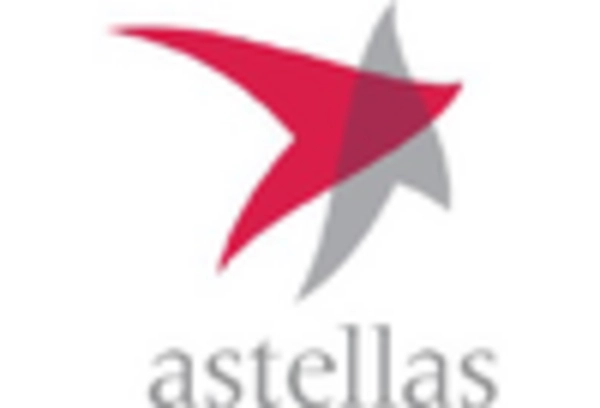Regulatory Approvals and Market Access
Regulatory approvals for new calcineurin inhibitors and their subsequent market access play a crucial role in shaping the Calcineurin Inhibitor Market. The approval process, while rigorous, ensures that only safe and effective medications reach the market. Recent approvals of novel calcineurin inhibitors have expanded treatment options for patients, thereby enhancing market dynamics. Furthermore, favorable reimbursement policies and streamlined regulatory pathways can facilitate quicker access to these therapies. As healthcare systems increasingly recognize the value of calcineurin inhibitors in managing chronic conditions, the market is likely to experience growth. This regulatory landscape indicates a positive outlook for the Calcineurin Inhibitor Market, as new entrants and existing players seek to capitalize on these opportunities.
Advancements in Pharmaceutical Research
Ongoing advancements in pharmaceutical research and development are likely to propel the Calcineurin Inhibitor Market forward. Innovations in drug formulation and delivery systems enhance the efficacy and safety profiles of calcineurin inhibitors. For instance, the development of novel formulations that improve bioavailability and reduce side effects could attract more healthcare providers to prescribe these medications. Furthermore, the increasing investment in biotechnology and pharmaceutical sectors, estimated to reach billions in the coming years, suggests a strong commitment to discovering new calcineurin inhibitors. This focus on research not only aims to expand the therapeutic applications of these drugs but also to address unmet medical needs, thereby driving growth in the Calcineurin Inhibitor Market.
Increasing Prevalence of Autoimmune Diseases
The rising incidence of autoimmune diseases, such as rheumatoid arthritis and psoriasis, appears to be a primary driver for the Calcineurin Inhibitor Market. As these conditions become more prevalent, the demand for effective treatment options escalates. Calcineurin inhibitors, known for their immunosuppressive properties, are increasingly utilized in managing these diseases. According to recent estimates, autoimmune diseases affect approximately 5-8% of the population, leading to a substantial market opportunity. The growing awareness and diagnosis of these conditions further contribute to the market's expansion, as healthcare providers seek innovative therapies to improve patient outcomes. This trend indicates a robust growth trajectory for the Calcineurin Inhibitor Market, as pharmaceutical companies invest in research and development to meet the rising demand.
Rising Awareness of Immunosuppressive Therapies
The growing awareness of immunosuppressive therapies among healthcare professionals and patients is a significant driver for the Calcineurin Inhibitor Market. As more patients become informed about their treatment options, the demand for calcineurin inhibitors is likely to increase. Educational initiatives and clinical guidelines emphasizing the role of these drugs in managing various conditions contribute to this trend. Additionally, the market for immunosuppressive therapies is projected to grow substantially, with estimates suggesting a compound annual growth rate of over 5% in the next few years. This heightened awareness and acceptance of calcineurin inhibitors as viable treatment options may lead to increased prescriptions and, consequently, a more robust market presence.
Emerging Markets and Expanding Patient Populations
Emerging markets present a significant opportunity for the Calcineurin Inhibitor Market, as expanding patient populations drive demand for effective treatments. Countries with developing healthcare infrastructures are witnessing an increase in the prevalence of chronic diseases, necessitating the need for calcineurin inhibitors. The rising disposable incomes and improved access to healthcare services in these regions further contribute to market growth. It is estimated that the demand for immunosuppressive therapies in emerging markets could increase by over 10% annually, reflecting a substantial opportunity for pharmaceutical companies. This trend suggests that the Calcineurin Inhibitor Market may experience a shift in focus towards these regions, as companies aim to meet the needs of a growing patient base.

















Leave a Comment